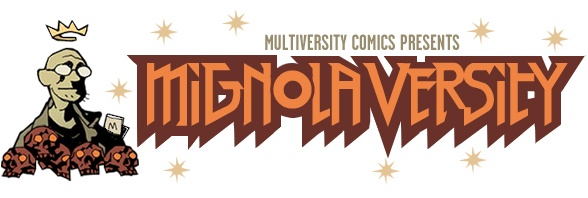
I hope you enjoyed the first issue of Baltimore: The Witch of Harju yesterday. We’re in a new phase of the series now! It seems like a good time to have a chat with the creative team behind the books about it all, don’t you think?
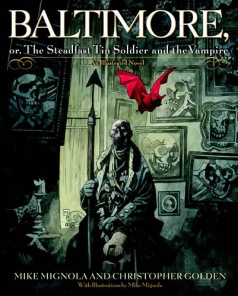
Could you tell us a little about adapting this story from comic to illustrated novel, Christopher? Was the story within a story approach always a part of the original concept, or was it something that evolved as you adapted it?

writer and co-creator.
As for the story within a story approach, that was absolutely an element of Mike’s original concept–that the novel would be the three guys sitting around in a depressing-as-shit inn, telling the pieces of Baltimore’s story that they know but also telling their own stories of the supernatural. Two of those stories were invented by me, the third by Mike, and we fleshed out those three characters together. Rose has been a particular favorite of mine, although I liked writing Aischros best (in the novel). Though I did write all of the text of the book, Mike and I worked very closely, so that even a lot of the imagery I used either came from him or came from our conversations. We have very different personalities, but we have a lot of the same enthusiasms and a broad shared frame of reference, which helped immeasurably.
I’d actually read the novel before the comic series, so the the comic always feels most like the novel when there’s a story within a story, like in The Inquisitor, which was a letter to Baltimore within which lay another story, the inquisitor’s tale. And I too have a certain fondness for Aischros. His story in Cicagne with the giant puppet was my favourite sequence from the novel.

CG: While writing the novel, Mike and I were well aware that we had left a large gap in the middle of the story, years in which Baltimore was hunting Haigus. While we talked briefly about doing a sequel novel, the only discussions we ever had about those intervening years was about doing them as comics. Particularly given how profusely illustrated the novel is, it always felt to us like a story that bridged the two mediums. Now the comics have taken on a life of their own. The more we’ve delved into it, creating the New Inquisition and Judge Duvic and Simon Hodge and other characters, elaborating on the history of the High Priests of the Red King and other elements of what this world is like now, the more the comics series becomes our primary medium for telling this story.
Continued belowDo you have an interest in exploring Baltimore in further prose, like perhaps short stories as backups in the single issues, or is it only a comics world now?
CG: For the moment, it’s just a comics world, but I’ve been thinking about doing more prose stories. We shall see.
What was it about Ben and Peter that made them the right artists for Baltimore?
CG: That’s much more a question for Scott and Mike than it is for me, but I’ll say this: they’re both brilliant, with an attention to detail that lends itself to the period work and the cinematic unfolding of action… but also to the emotion on the faces of the characters. That stuff helps so much in telling the story. I’m very fortunate to have worked with these two amazing artists on Baltimore, not to mention legendary colorist Dave Stewart, who makes everything better.

editor.
With Peter it was harder—Ben had shown us what Baltimore should look like, but we didn’t want a Ben clone. I believe strongly in avoiding art clones. An artist needs to be great on his own merits, or it doesn’t count. We didn’t hire Duncan for Hellboy because of his similarities to Mike—we hired him because we thought no one could do that comic better. So with Peter, it was inevitable that we’d stylistically go in a new direction. Just as it was natural that Peter would at first be confused, try to do a little of Ben’s style, or a little of Mike’s style.
We know going forward that Baltimore would be traveling across Europe and encountering some new bits of European folklore. We felt that Peter could bring that to life really well. We had perfect examples of his work to look at, some of which we’d published. One of the interesting things is that now with the first chunk of it done, we’re seeing that Dave’s coloring Peter different from Ben. Dave is maybe the biggest fan of this book. Dave loves Baltimore. And I assumed that he’d bring the same color style to the new book, that that’s how he saw Baltimore. But it’s different in some key ways, and it’s really nice. He’s making the book its own thing. Everyone is.
Ben, you’ve had the challenging task of translating parts of the original prose novel into comics, which I can imagine was rather intimidating. How do you even begin to attack those sequences?

artist (most of Baltimore).
CG: In the parts of the comics series where we adapted portions of the novel, I’d frequently actually put parts of the narrative description from the novel into the panel descriptions so Ben could see the tone we were trying to achieve. Most artists would have found it difficult or impossible to translate the tone as delicately or specifically as we wanted, but he does it every time. Ben was a great artist before he started work on Baltimore, but within the first couple of issues he went from great to startlingly adept.
Having read the book, if I’d had to draw the final scene of Chapel of Bones with Baltimore ripping his heart out, I would have buckled under the pressure (even if I had your talent, Ben). When a scene’s written that well, I can’t imagine it not being intimidating. But what you and Christopher did really worked. There was a scene, the last page of the first issue, that I thought was very cleverly done. In the novel it read as:
Continued below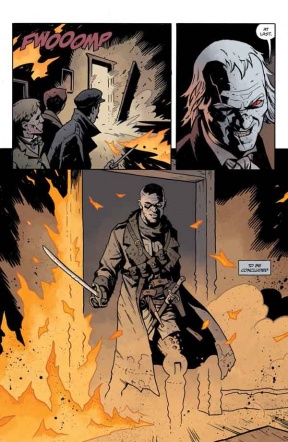
The frame cracked as [the door] burst open, tearing from its hinges and falling, ablaze, to the floor. Yet, somehow, Aischros felt a chill in the room, as though the fire had suddenly been robbed of its heat.
Lord Baltimore stood upon the threshold, cloaked in his military greatcoat, weapons hanging all about him. Firelight flickered and gleamed upon his shaven head, and wide dark eyes.
What really got me was that line about there being a chill in the room. You can’t draw that in a comic. But by adding a panel of Haigus going, “At last,” the pair of you found a way to put a chill in there. I was genuinely surprised by how many nods to even single lines in the novel there were.
BS: Ha, see I read that stuff from the novel and think, Ah crap, I should have drawn that moment better. That moment you’re talking about is down to Chris really. Something like the heart being taken out, Mike has a really specific idea about how a moment like that is supposed to work. I can’t remember specifics but I know there was a lot of back and forth with Mike over that moment.
CG: I like to think that most of the time I’ll get something 95% of the way there. Maybe even more. But Mike always sees the moments that I’ve missed, the opportunities for some subtlety that will really make something work. Sure, he’s one of the greatest and most imitated artists in the history of comics, but I believe his real genius is in that element of storytelling. When to hold something back. When not to show the full picture. When to whisper instead of scream.
So how involved is Mike Mignola with the art? I find the works he’s involved in, even when he’s not drawing them, tend to have a very specific pace to them. And in the hardcover collections for Baltimore, the sketchbooks seem to show he’s very involved in the design aspect of the stories.
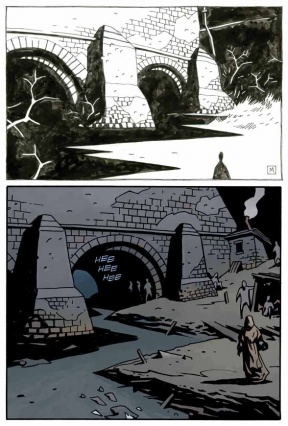
Below: A scene from Chapel of Bones.
BS: Yeah, I always go over my layouts with him and there’s always a few things he wants done differently, and he’ll explain why something needs to be done a certain way. So it’s been great, I’ve learnt so much in the last couple years. But after working with him for almost 6 years he tends to say “I trust ya” a lot. I don’t trust myself with this stuff but he seems to and that’s what counts, I guess. Mike didn’t do a lot of designs on Baltimore. I don’t remember getting much in the way of design sketches. At least not as much as I was getting on Witchfinder. The thing I’m working on now, I’m getting a lot more of that stuff from Mike and it really makes a big difference. So yeah Like Scott says we sort of have this really good understanding at this point.
SA: Mike trusts Ben a lot. We all do. He’s really earned the spot.

artist (The Witch of Harju).
If I have to say one thing that opened my eyes it’s that the first page I inked looked way too much like Mike’s stuff. Scott told me that they wanted my style and I did a lot of second guessing as to what that really was. Scott has been awesome, really pushing my art to the next level. Getting back to Ben, we talked a bit about picking up where he left off. Our styles are similar enough that I could try and bring his character designs over to my own work. He’s done some spectacular work on the heroes in the book. I just tried to add my own ideas to that.
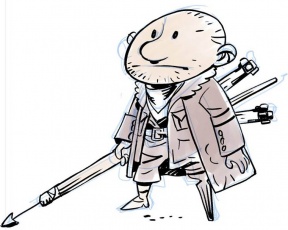
CG: Peter sells himself short here. His work is obviously different from Ben’s, but beautiful in its own right. It’s detailed in all the right ways, but still manages to have a wildness to it that’s perfect for a story like The Witch of Harju.
The Witch of Harju is the first time an artist other than Ben has handled the art on the series. It’s interesting that you spoke to each other about the visual continuity. That’s one of the things I admire about Mignola’s comic universes, is the way there is communication between artists. It keeps everything feeling very cohesive.
BS: Well, Peter’s a really accomplished artist, it wasn’t like I had anything to tell him. We just had a bit of back and forth because I was doing covers for comics he was drawing so I didn’t want to paint him into a corner with anything I did on the covers.
PB: There was this bit about his cloak and Baltimore having gone through a bunch of them. He doesn’t have a fixed set of items/weapons, so I actually gave him an old government model 1911 Colt 45 that he uses in a few panels. Can’t remember if I’ve seen him with one of those before. I find that I work less well when having to rely too much on reference. So instead of constantly referring back to the way Ben draws the sword, I did my own take without over thinking it, meaning that every single time I draw it, the design will be from my head and readily available. The rifles were harder and I kept them on a second screen for most of the first issue. I think I can draw them in my sleep now.
I should add that Chris and I actually worked on a Hellboy novel for the RPG, so this isn’t really the first time we work together.
SA: There was a novel?
PB: Just a short one involving tigers. I guess the language barrier got in the way, should’ve said “novella”. In Sweden “novel” is the short form.
SA: A short NOVEL? Wow, no memory of that…
CG: Peter means a short story.
PB: I clearly made my mark with that one.
CG: It was a short story called “Dakini.”
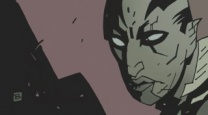
SA: I definitely recognize THAT guy!
PB: I got to draw Hellboy as well but am WAY too embarrassed to show those. Some things are better left hidden in the vaults.
SA: It’s not a bad thing that I know you more for your own work, which I think, if I recall, I was the one who pushed to do at Dark Horse, though it all has gone through other editors.
PB: Yeah, you were instrumental in getting Domovoi to Dark Horse. For which I am ever grateful.
Back in June Scott mentioned in the Hellmail letters column that the fourth Baltimore collection would be the last entirely drawn by Ben Stenbeck [This has since been announced, the two-issue miniseries Baltimore: The Wolf and the Apostle]. What does this mean for the future of Baltimore in terms of the art?
Continued belowPB: I have no idea.
CG: I don’t think anyone knows the answer to that.
SA: Aren’t we making this sound overly ominous when we’re just not ready to announce anything?
CG: I didn’t mean to sound ominous. I just don’t know the answer. Nobody tells me anything!
SA: My communication has not been what it should be.
CG: Well, Mark… I could tell you that Mike and I have plotted far in advance and we know how it’s all going to end, but then I’d have to ask Scott to send out the Dark Horse assassins.
SA: Perfect–Mark is actually one of our sleeper agents. Mark, contain the threat.
It’s true. I usually have to kill all the readers of our interviews.
PB: I know I am just hoping the fans won’t have a fit when they see my art. Switching artists after such a long run can be tough on the readers. I know I kept reading Hellblazer over the years and just dreading when my favorite artist would quit (Marcello Frusin).
I found your run from Ben’s to be an incredibly smooth transition. Artists in comics fulfill an incredibly wide array of duties. If you’ll excuse me using cinematic language for a moment, they’re designers, cinematographers, co-directors with the writer, choreographers, and actors. For a smooth transition, the artists need to be compatible in these disciplines (though not necessarily the same), especially in terms of tone and the acting. The level of performance an artist can get out of a drawing is of exceptional importance, and it’s part of the reason The Witch of Harju was a very smooth transition. Yes, it is different, but the heart of Baltimore is still there (even if he did rip it out at the end of the previous arc).
PB: Yeah, the acting out part is fun if a bit unnerving for family members. I keep a stash of weapons (doesn’t everyone), including an assortment of swords and guns. I usually don’t rely on photo refs, but there might be an odd angle I can’t fake and out come the guns. I think I and Ben have similar enough sensibilities when it comes to design and cinematography.
For Ben Stenbeck, he’s always been drawing from New Zealand, using reference to create a Europe overrun with the vampire plague, but you’ve also got your experience to draw from. The Witch of Harju is set in Estonia, which is just across the Baltic Sea from your native Sweden. Did you find there was much you could draw from when creating Baltimore’s world?
PB: Absolutely. Estonia was part of Sweden a long time ago so we share a bit of history. Lots of Estonians over here which meant that I could just reach out and ask for reference. As far as houses and clothes from around that era, much of it looks exactly like Sweden from the same time period. I love drawing narrow streets and old houses and could actually pull inspiration from my hometown where some of these houses are still standing. I took a few liberties like putting in cobble stone streets where it would probably have been mud or planks. Stone just looks better and actually more realistic. But the thing that I drew most from was the forest at dusk in the first issue. Growing up in a similar are I knew what it would feel like to be there and I was so happy to see the colors on those pages matching exactly what I had seen in my mind.

I contemplated taking a trip over to Estonia since the ferry goes there every day but realized there was very little in modern day Estonia I could use. Chris has been generous feeding me photo references that I use as a starting point. Chris is killer with stuff like this. He wrote a Hellboy story once set in Old Town in Stockholm and I swore that he had been here soaking up the ambience, but alas, he had not.
Was that The Bones of Giants? It’s the only one I haven’t read yet. Those three Chris Golden novels need to be reprinted in a nice hardcover together…
Continued belowPB: I think that’s the one. I have all of them in my house but I’m in Stockholm at the moment (we live in a small town, pop 5,000 and in Stockholm).
CG: I should add that, quite happily, I have since been to both Stockholm and Tallinn (Estonia).
SA: Going back to an earlier point, the thing I love about working with artists from other cultures is that they can bring in such interesting influences, they can make the familiar seem a little unfamiliar, which I think is great for comics—all comics, especially alternative history comics like this. Comics have a natural level of surrealism to them, and so having these guys do their version of this particular Europe is a nice contrast to what our audiences might be used to, which is simply a very American version of this particular Europe. You see the world through your own lens, and bringing a Swedish lens or New Zealand lens is a nice touch.
Was The Witch of Harju conceived specifically for Peter to draw? I know in the past there have been stories like Dr. Leskovar’s Remedy, which I believe was largely written based on what Ben Stenbeck wanted to draw. Was there much back and forth in regards to the shape of this tale?
PB: No back and forth at all actually, as far as the story goes at least, but I felt as if Chris wrote stuff for me anyway. Like the cat. I love drawing cats. So maybe it was written for me, but I have no idea.
BS: The stories are really all Chris and Mike. I mostly talked to Mike. Something like Dr. Leskovar’s Remedy came from a conversation I had with Mike where I threw a bunch of ideas at him. He took some of those and went back to Chris and then at some point Chris asked me if there was anything I wanted to do in issue 2 so there was something I added which sort of became the last half of issue 2. So that series is the closest I’ve come to being involved in the story, so I have a soft spot for that series.

Ben Stenbeck's last Baltimore story.
I read a review once where the reviewer gave credit to Chris for something that was all me and then gave me credit for something that was all Chris, and I thought, “That’s awesome. That’s the way it should be.” The comic is one experience and you shouldn’t be able to see where the writer stops and the artist starts.
SA: I think with the overall Mignola group of books we’ve managed a nice balance of what Ben’s talking about. We work around a certain vision of mysterious comics set in a horror milieu, we orbit Mike’s vision, and everyone is pretty happy to do it because it’s a pretty solid vision. But then we do Chris’s version of it, Ben’s version of it, Arcudi, me, etc. The difference with Baltimore is of course that Chris and Mike co-own it and co-created it, but it’s still very akin to that vision that gave us Hellboy and Abe Sapien.
Comics invites a level of collaboration that’s really wonderful, where the lines blend. Baltimore will evolve with Peter on board now, but the vision will remain pretty true, and Peter was selected because we felt that what he brings to it can align fairly easily with what we’re trying to do—but, as I think he said earlier, we don’t want him to ape Mike, or ape Ben, because he’ll never be as good doing that as he is doing his own thing.
Continued belowCG: Yep. I’m currently plotting Volume Six and I’m so curious to see how it evolves with Peter.
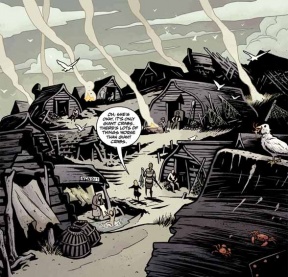
This is why it’s so difficult to separate what the writer does and what the artist does, and I’d argue that the harder it is to tell, the better the book often is. And design is such a crucial part of comics story-telling. That upside-down boat shanty town says so much about the plight of those people. What could have been a huge chunk of exposition in dialogue becomes the scene and the atmosphere instead.
Peter and Ben, what were your visual influences specifically in regards to Baltimore. Obviously the story has its roots in Moby Dick and Dracula (among others), but was there anything in particular you found helpful, even if it was a novel or a comic that you just wanted to emulate the mood or pace of?
PB: That’s a great question. So much of this for me is pure intuition, I know what I like and I go for it. But that usually happens when I color my own stuff. This was different, whenever something doesn’t look like I have these mental images of what it should look like. That’s when I start to second guess my own style and ask, how would Bernet have inked it, how would Alcala or Redondo have done it? I try not to go to the obvious source because that would probably lead to it looking like an inferior copy of Mike’s style. There’s a bit of Ivan Bilibin in the trees for sure, but Bilibin was always more of a source for coloring for me. Carl Larsson is always a huge influence and when drawing stuff like wrinkles, that kind of heritage creeps into my art. But I have a couple of books lying around for pure inspiration injection and I can rattle them off for you:
Michael Moorcock, Stormbringer
Mignola, Hellboy: The Island
Pierre Christin and Jean-Claude Mézières, Valérian and Laureline: Heroes of the Equinox (shamefully not available in the US)
Jean Giraud, Blueberry: The End of the Trail
BS: The thing I always had in the back of my mind was those really dark New Zealand films. There’s one called “UTU” that I thought of as influencing the atmosphere of Baltimore. I can’t think of many films that make everything seem as gross and ugly and smelly as that film. I never watched it while I was working on Baltimore, but I was thinking of it. I always tried to make everything in Baltimore feel like it was rotten. I hope when you see any food in Baltimore it makes you feel a little nauseous. I don’t know, I just thought it was a fun opportunity to build this nasty world with no comfort anywhere. “The Piano” is another one. Everything’s just wet and cold and miserable. That seemed like the right sort of setting for Baltimore.

I think you captured that particularly well in the short story, The Tank. Combined with Dave Stewart’s colouring, that food did not look pleasant. Plus I just loved Baltimore’s interaction with the child in that sequence. The kid pushed him to be more expressive than usual.
Continued belowBS: Thanks. Yeah, where would we be without Dave Stewart?
CG: Those panels with the kid were exactly what I hoped they would be. It’s one of my all time favorite scenes in Baltimore.
I’ve often found Baltimore to be at his most interesting when he has someone to play off of, especially if it’s someone he’s feeling impatient with. It’s one of the reasons Simon Hodge endeared himself to me so quickly, and the vulnerability of that character was what gave The Inquisitor such tension. Could you talk a little about how the expanded cast affects the dynamics of the book?
CG: I think we’ll learn a lot more about this as we go forward. Like Judge Duvic, the supporting cast helps to define Baltimore by allowing us to contrast them with him. I’m not going to spell out what I want readers to take away from the contrast between Baltimore and Childress or Baltimore and Hodge… or Baltimore and Duvic for that matter. That’s something readers can figure out for themselves. I do think it’s important to note, however, that the less human Baltimore feels, the more he wants to surround himself with humanity. At least so far.
That makes sense. On occasion Lord Baltimore has demonstrated a distaste for his humanity, as though if he could get rid of it, he would finally catch Haigus. Yet he could never truly forsake his humanity, and the shred that remained kept him from utterly losing himself. One thing that’s kept Baltimore going for much of the series so far, was the thought that when his task was done, he could finally die and rest at last with his family. His motivation for hunting Haigus was peace for himself and his family. But in Chapel of Bones he was robbed of this. Going forward, what is Lord Baltimore’s motivation now that he’s essentially immortal? And what’s keeping him human?
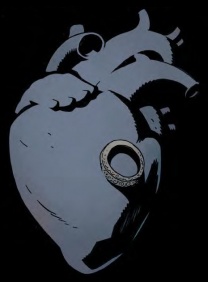
Most of the comic’s run had been solely focused on Lord Baltimore and his pursuit of Haigus. With the end of Chapel of Bones, which tied up the events of the novel, the comic has now stepped out into a much broader world. In particular, Baltimore has been joined by Childress, Aischros, Dr. Rose, the journalist Simon Hodge, Quigley (who made his first, and probably last appearance in The Witch of Harju #1), and Harish and a fellow with a blond beard glimpsed briefly in the end of Chapel of Bones. For comics-only readers, The Witch of Harju, further acquaints readers with Aischros and Childress, and introduces the character of Harish. Can we talk a bit about the expanded cast and who they are?
CG: Readers of the novel will know Dr. Lemuel Rose, Thomas Childress, and Demetrius Aischros from the novel and from Chapel of Bones. Childress was a childhood friend of Baltimore’s on Trevelyan Island, the location of the Baltimore estate and the region’s baronial seat. Dr. Rose was the army surgeon who amputated Baltimore’s leg after his first encounter with Haigus during World War I. Aischros was the sea captain who met Baltimore while ferrying soldiers—injured and otherwise—back to the mainland when the plague effectively put an end to the war. Read the novel or Chapel of Bones for more about them.
Continued below
With the expanded cast, it seems the shape of Baltimore is going to be very different going forward. There was a particular note from the epilogue of Chapel of Bones I found interesting. Dr. Rose had lost four fingers, but on those final pages he has surprisingly mobile wooden prosthetic fingers, much like Lord Baltimore’s leg. It seems to me Baltimore’s companions are becoming more like him as they shoulder some of his burden. It’s like there will eventually be a group of broken tin soldiers.
CG: It’s not wrong to suggest that his followers reflect him, but only in the sense that a child echoes his or her parents in appearance and mannerisms. Every one of Baltimore’s followers has encountered the supernatural and been scarred by it in some way, but they have not been TRANSFORMED in the way that he has, both physically and spiritually. They are broken, and somehow stronger for it, but they are only human. I think we’ve made it very clear by now that Baltimore is not quite human anymore. This journey he’s on—it would probably be better if he undertook it alone, but after a long time believing that he had to do that, he’s decided that perhaps he doesn’t. The battle against the darkness is one thing, but his mission is something else—within the larger fight, but also separate from it.
I think that’s a real evolution of the character. Up until that point, he was serving revenge, which is ultimately self-serving. Now he’s taken on a mantle to save the world, I guess, and he’s realised it is not his fight alone.
CG: Certainly our intention. Although I’d add that it’s more that he’s consciously unwilling to tell these people that they don’t have the right to pursue their own crusade against the darkness than that he’s recruiting for his own. Again, consciously. I don’t think he’s entirely conscious of the fact that he has other motivations as well.
Lord Baltimore was hunting vampires for something like four years, and in that time he managed to find and kill many of the old ones, the original vampires. In The Infernal Train he managed to take out several at once. And now that he’s killed Haigus, I have to wonder are there any old ones left? Will the Baltimore series be stepping back from vampires a bit and dealing with more of the other sleeping horrors that have awoken? One aspect I’ve enjoyed in particular in the comics is the grand fantasy horrors, like the jellyfish in the storm in The Plague Ships, the serpent in the church in The Curse Bells, and the spiders in A Passing Stranger.
CG: I don’t want to talk too much about what’s to come, but yes. Certainly the original vampires, the High Priests of the Red King, have been decimated by Baltimore after the events of The Infernal Train and Chapel of Bones. I imagine there are a number of them remaining, but they could be hibernating the way Haigus and his clan were, and others could be scattered around. The fundamental threat is that the Red King is the most ancient of evils, the god before gods, and all of the monsters of history are his children or descendants. Most of them are long gone from the world, but many are now being dreamed back into existence by him as he is strengthened by the worship of the High Priests and, now that they’ve reintroduced worship of the Red King into the world and the plague and the vampires have sown fear of him, there are others who worship him. We’re going to meet some of those worshippers and see the result of that. As I’ve said before, we ARE going somewhere with all of this.
Continued belowLord Baltimore’s going after the Red King, but how can he and his companions even begin to fight a god?
CG: If you want to destroy a god you start by destroying the faith of those who worship it. Of course, that’s easier said than done. As for where we’re going with it, do you honestly think I’ll tell you?
I’d prefer you didn’t. I like surprises. Although I do like teasers. Before we wrap this interview up, would you care to give our readers a final tease?
SA: How about this? We know Hellboy fans like cats. Peter draws scary cats.
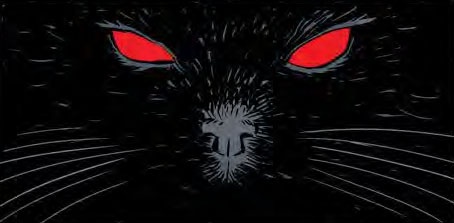
PB: Love cats.







